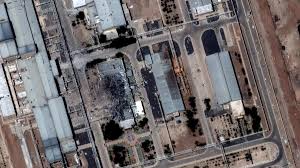US strikes didn’t destroy Iran nuclear sites, only set back programme by months: Pentagon report

A recent Pentagon report confirms that US airstrikes on Iranian nuclear sites did not destroy the infrastructure. Instead, they caused only a temporary delay of a few months. This new information challenges earlier claims that the strikes crippled Iran’s nuclear progress.
Targets Hit, But Core Facilities Survived
The US military carried out airstrikes on several high-value Iranian nuclear sites earlier this year. These included uranium enrichment centers and facilities used to develop advanced centrifuges.
Despite hitting the intended targets, the strikes failed to eliminate Iran’s nuclear capacity. Many sites were built deep underground or reinforced to survive air attacks. The Pentagon report estimates that Iran’s nuclear program was only delayed by three to six months.
“The damage disrupted operations temporarily but didn’t destroy Iran’s core capabilities,” the report stated.
Iran’s Quick Response Shows Resilience
Iran acted fast after the strikes. Officials launched immediate repair efforts and resumed activities in several locations. Satellite images and other intelligence confirm that operations restarted at a surprising pace.
Iranian officials issued strong statements. Mohammad Eslami, head of Iran’s Atomic Energy Organization, said the attacks would not stop Iran’s progress. “No military action can halt our peaceful nuclear development,” he stated.
US Allies Concerned About Limited Results
The Pentagon findings have raised alarm among US allies. Israeli officials, in particular, expressed concern that the strikes fell short. They worry that Iran will return to full-scale enrichment activities soon.
Israeli Defense Minister Yoav Gallant commented, “A delay is not a solution. We must prevent Iran from ever obtaining nuclear weapons.”
European countries also reacted. Many called for renewed diplomatic talks. They urged both the US and Iran to return to the 2015 nuclear deal, known as the Joint Comprehensive Plan of Action (JCPOA). The US exited that agreement in 2018.
Military Approach Faces Criticism
Experts are now questioning the long-term effectiveness of military solutions. Analysts argue that strikes may delay programs, but cannot eliminate nuclear knowledge or stop determined nations.
Dr. Rachel Connors, a non-proliferation expert, said, “Bombs can destroy buildings, not expertise. Iran’s scientists still have the knowledge and tools to rebuild.”
Critics also warn of the risk of escalation. In recent weeks, Iranian-backed militias have stepped up attacks on US bases in Iraq and Syria. These could be responses to the strikes, signaling rising tensions.
IAEA Monitors Iran’s Enrichment Efforts
The International Atomic Energy Agency (IAEA) has tracked Iran’s nuclear activities closely. Iran continues to enrich uranium at levels close to weapons-grade, alarming global powers.
Although Iran insists its nuclear program is peaceful, many countries remain skeptical. The Pentagon report reinforces the belief that Iran could reach “breakout capacity” within months. Breakout capacity means a country could produce a nuclear weapon quickly, if it chose to.
Urgent Need for Diplomacy
The limited impact of the strikes has increased pressure for diplomatic solutions. The Biden administration says it is open to renewed talks, but Iran must stop enriching uranium beyond JCPOA limits.
Iran, in contrast, wants sanctions lifted before any negotiations. This demand has divided US lawmakers and international partners.
UN Secretary-General António Guterres called for restraint. “Both sides must return to dialogue. Further escalation will only worsen regional instability,” he warned.
Time Is Running Out
With only a short delay achieved, the clock is ticking. If Iran continues to rebuild quickly, the risk of a new nuclear crisis will rise. Experts say now is the time for serious negotiations and international pressure.
The Pentagon report is a reality check. It shows that military action alone cannot solve the Iran nuclear issue. A long-term solution will likely require a mix of diplomacy, intelligence, and economic strategy.
Conclusion
The US strikes on Iran’s nuclear sites delivered only a short-term setback. Iran’s program remains largely intact, and efforts to rebuild are already underway. The Pentagon’s findings suggest that the world must now shift focus from military tactics to diplomatic engagement.
Time is limited. Without a broader strategy, Iran’s nuclear ambitions may soon reach a dangerous turning point.






